In the past five years, Pepper has worked on more than $500 million in commercial office projects. We have worked with a range of clients, from Fortune 500 companies to young tech companies, and from traditional, class A office space too-location space. While each space is a unique reflection of the company and the people they employ, we have seen 10 trends emerge that have re-defined today’s workplace.
01. Mobile workforce
In the world in which we live today, people’s lives are growing increasingly busy. Rising demands on the workforce have made working remotely a more desirable option. According to Global Workplace Analytics, 80-90 percent of the workforce wishes to work remotely at least part-time and 50 percent of the workforce is currently working remotely in some capacity. Cloud and web-based software is changing the workplace as we know it, making it easier for employees to work wherever they wish. Less space is dedicated to on-site data storage, with more wireless technology to meet the needs of employees. Occupancy counts have gone up as employees require less space because they are more efficient with how it is used.
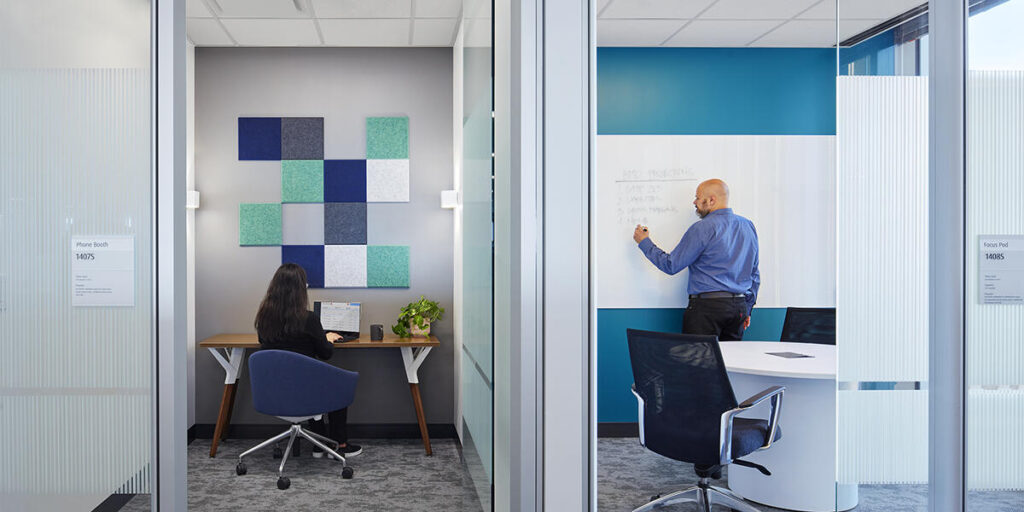
10 trends changing the post-COVID-19 workplace environment
Workplace
01. Health and wellness

Pepper’s new Dublin office, which is seeking WELL Silver certification, was designed with consideration for the employees’ health.
Design elements that focus on employee well-being will continue to play an important role. These include windows and glass partitions that let in natural light, fresh outdoor air, living walls and other biophilic features that bring nature indoors, as well as programs and amenities that support a healthy, active lifestyle.
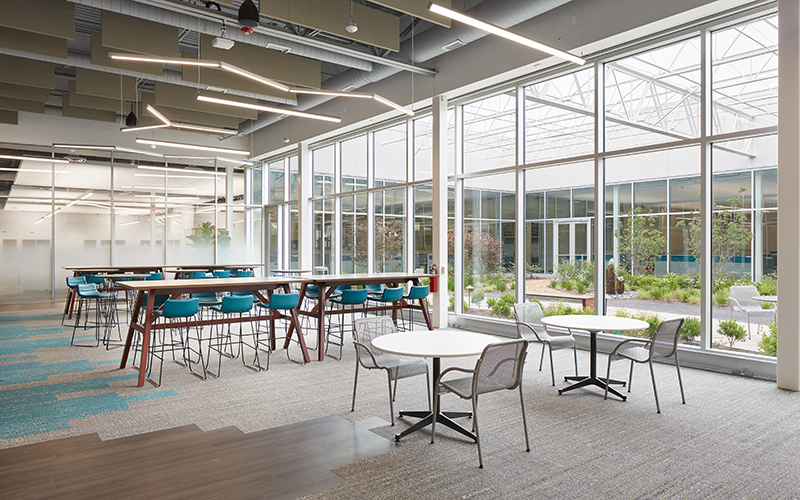
Interior spaces that bring outdoor elements inside support a healthier environment.
02. Remote workforce
Three years ago, we talked specifically about a mobile workforce, where people were on the go, working from different locations every day – in coffee shops, airports, etc. During COVID-19, the workforce shifted to WFH without another option. Now, the questions are how many employers will offer a permanent WFH option, and how much of the workforce will stay home. Some real estate companies and brokers are predicting about 30% of the workforce will make a permanent shift to a home-based work style or some version of it, and early on, many tech companies indicated they may never go back to an office environment, though that sentiment may be changing again.
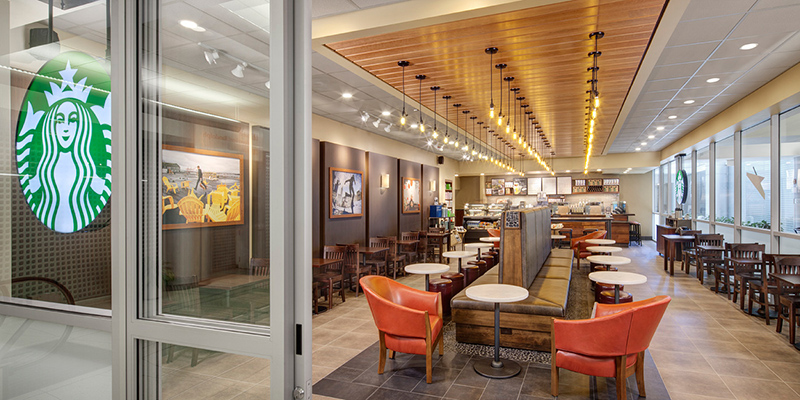
Coffee shops were once popular environments for the mobile workforce. Since the pandemic, remote work has shifted to WFH.
03. Decentralized offices
Are our downtowns forever changed? Pre-pandemic, there was a trend with headquarters moving back downtown as the workforce sought a more urban lifestyle. The jury is still out on the exact blend of downtown versus suburban office space. Right now, public transportation is suggesting there could be a flight to the suburbs. Trains are still empty, and highways are less crowded. The suburban commute into downtown is still trending sl-ow-ly.
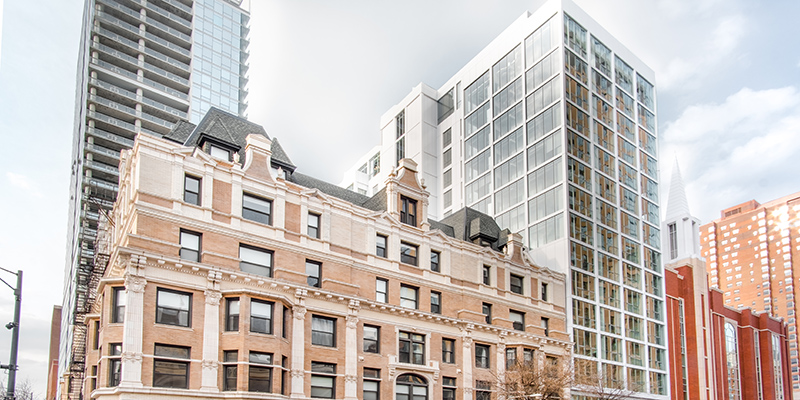
Following a downtown boom, employers are starting to consider locating closer to where their teams live, which brings into question the future of the downtown workplace.
What happens if businesses don’t fully return to downtown? Employers may map where their people reside and find space closer to where they live, which also brings the advantage of plentiful and free parking. Options include a hub-spoke set up, satellite offices or touchdown spaces that are operated by others. We may see demand for office space shift back to the suburbs.
04. Decluttering
Instead of personalizing the office space, personalization will apply to the work style. Working from home and additional cleaning protocols encourage more minimalistic and clean designs. Fewer picture frames and statues on display translate to fewer crevices for germs and dust to settle, which also makes cleaning easier. WFH is already reinforcing the trend toward electronic communication and filing, which reduces the need for paper, filing cabinets and related supplies.
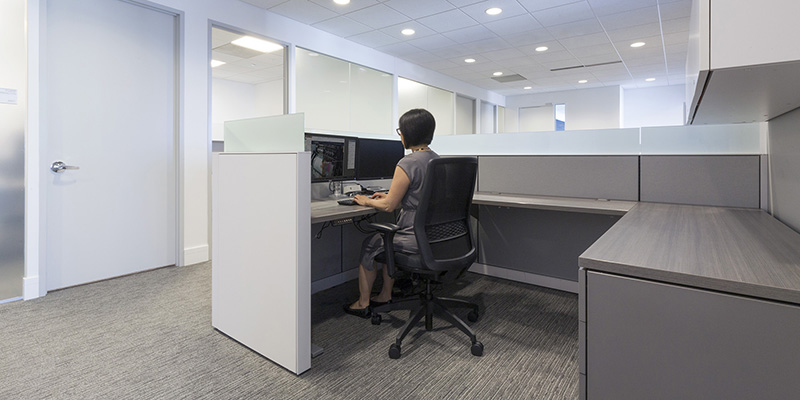
Desks have been cleared of personal photos and mementos to make cleaning and disinfecting easier.
05. New shared spaces
In the midst of warm weather, it’s convenient to extend the office environment outdoors and take advantage of the fresh air. Plazas, patios and terraces provide additional meeting spaces with nice views. We’re making use of our outdoor spaces right now. These outdoor spaces could become a selling point, but come winter with the bitter cold and harsh weather, our teams will be seeking other meeting space options. Indoor communal and collaborative spaces will have to meet new standards with different capacities.
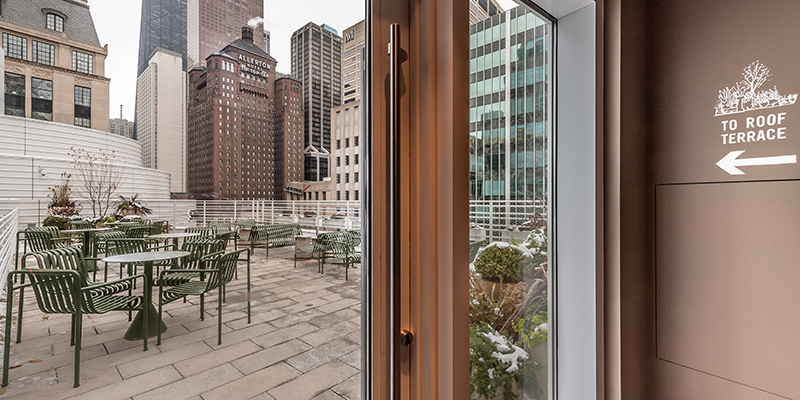
When the weather is nice, outdoor spaces are a good option for team meetings.
06. New furniture designs
We know new and creative furniture designs are coming. Right now, employers are making due with what they have by pulling every-other chair around the conference tables, raising screen heights and assigning teams to specific office days. Future furniture and fixture designs will expand on their current five-foot standards to consider the six-foot distancing rule and the spread of germs and other particulates.

Office furniture will be redesigned to new distancing standards.
07. Different amenities
We expect many amenities to remain the same. It’s the trends within them that are changing. We aren’t likely to see as many game rooms or music rooms, and café spaces will be reconfigured. Additionally, with daycare and school closings presenting challenges for employees to return to the office full-time, employers may start to consider on-site childcare and other amenities that help parents and families.

Different amenities, like on-site child care, may become a higher priority to bring employees back into the office and encourage work-life balance.
08. More technology
State-of-the-art HVAC systems, touchless fixtures, remote and voice-activated systems, electronic devices and robotic sanitizers will become the new norm. The race toward innovation and advancements in technology will be incorporated into every aspect of the building and will be used for communication, wellness and for building operations. Tele-data needs and space requirements will depend on the types of technology used.
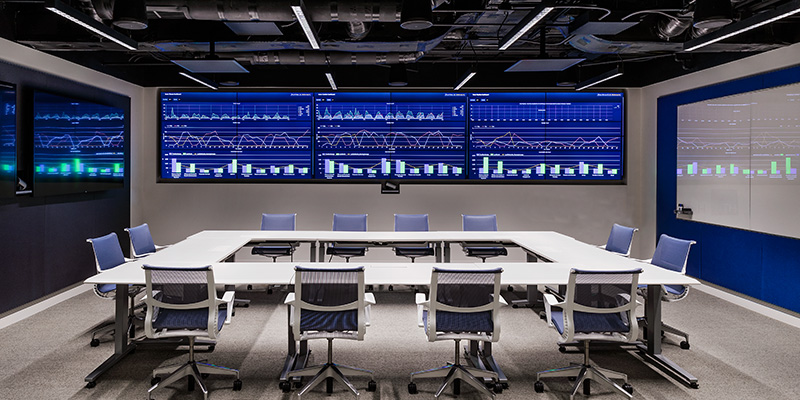
The office of the future will not only feature the latest technology for communication and work efficiencies, but it will also be operated with state-of-the-art technology.
09. Redefined culture
The workplace has been integral to establishing the company culture and building connections. In recent years, corporations have relied on their facilities to help build and maintain their brand and to attract and retain top talent. Instead of encouraging “culture-centric” design, employers are in culture shock as they look for new ways of building their brands outside of the office. If employees are the brand, what does a dispersed workforce do to the corporate identity? Branded backgrounds on Zoom calls and electronic communications are only a short-term solution to a growing concern. Will corporate identity influence a return to the office, or will what we know as the current “modern” design become tomorrow’s traditional office?

The workplace is considered part of the company culture and is used to reinforce the brand. As the workforce continues some form of remote working, companies will look for other ways of connecting their teams to each other.
09. Redefined culture
What will WFH and new office spaces do to our productivity? Companies and architects are starting to study the pandemic’s effect on the workforce, but we don’t have the full picture yet. All the changes we have experienced so far could result in additional changes in how we work. The workplace market has also started to incorporate pandemics and WFH standards into resiliency plans, with items such as rehearsed Information Technology (IT) responses. And Force Majeure is already entering conversations, as tenants now want minimums and guarantees in their leases that allow for cancellations due to “acts of God.”

As the need for space shifts, companies are starting to sublease unused portions of their Class A office space, which is changing the demand for building owners, developers and brokers.
What I haven’t discussed is the overall shift in demand that we are seeing, which is affecting lease deals and building types. Tenants are demanding higher quality features and amenities, and corporations are meeting the demand by subleasing raw or lightly used portions of their new Class A spaces. This wholesale movement is sure to impact rental rates. This will present favorable opportunities for tenants but will create a depressed business climate for office building owners, developers and brokers. Class B and C office building owners will scramble to satisfy post-pandemic tenant requirements given physical constraints such as small elevators, and older HVAC and MEP systems.
These are the trends we see today that are impacting the future of the workplace. Because the changes were immediate and born out of necessity and not choice, there seem to be as many questions as answers right now. As the situation evolves, we’ll provide updates. Our hope is that we look back on the other side and realize we’re better off — with stronger teams, healthier buildings, better balance and a brighter outlook.

